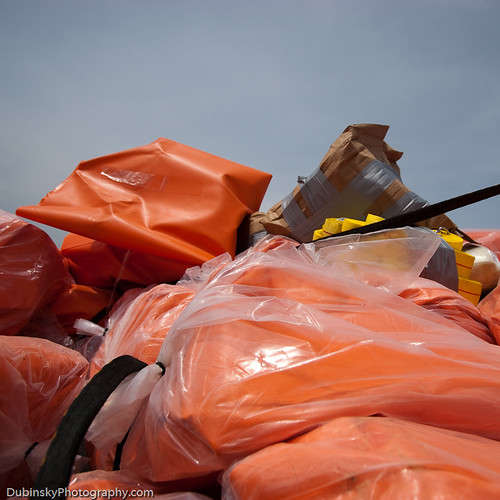Dispersant Information 0
Dispersants are being deployed in the Gulf of Mexico to break down oil in the slick, but what are in dispersants and how do t
Gulf of Mexico response
Dispersants are being deployed in the Gulf of Mexico to break down oil in the slick, but what are in dispersants and how do t
Gulf of Mexico response
Dispersants are being used in the Deepwater Horizon oil spill response. Dispersants are not safe to humans or the environment. They contain various industrial solvents and workers must be protected from exposure. Dispersants are usually applied directly to the spilled oil by spraying from an airplane, helicopter, or vessel. During the 1989 Exxon Valdez oil spill cleanup in Alaska, some dispersants were manually sprayed by workers on oiled beaches. Although dispersants are manufactured by many companies and their ingredients may differ, most contain a detergent and a solvent. The solvent allows the detergent to be applied. The detergent helps to break up the oil on the water surface into very small drops. These tiny oil drops are then able to easily mix with the water and be diluted. Most dispersants contain petroleum distillates, a colorless liquid with a gasoline- or kerosene-like odor. They are composed of a mixture of paraffins (C5 to C13) that may contain a small amount of aromatic hydrocarbons. Exposure to can cause irritation to the eyes, skin, or respiratory tract. NIOSH also recommends preventing skin contact with oil mist. To prevent harmful respiratory and dermal health effects NIOSH recommends reducing worker exposures to petroleum distillates and similar cleaning agents in dispersants. For more details, go to the NIOSH website at www.cdc.gov . This was clipped from video produced by the Governors Office of the State of Alaska in 1989 and 1990.
Video Rating: 5 / 5
In the Weekly Republican Address, Louisiana Sen. David Vitter discusses the tragic explosion and oil leak at the Deepwater Horizon rig off his state’s coast. Sen. Vitter reminds Americans, “As we continue to work toward a recovery solution, none of us should lose sight that there are families whove lost loved ones. That is the greatest tragedy something everyone in Washington should try a little harder to remember.” He also laments the politics swirling around this disaster: “I guess its typical of the culture in Washington for politicians to believe that they can solve an ongoing crisis with statements and testimonies in Congressional committee rooms. But the time for committee hearings is for after the well has been capped not before. Folks closer to the scene understand that. We want 100 percent of the attention of all parties focused on our two most immediate problems: stopping the gushing oil, and protecting our coastlines and marshes from the oil.” Sen. Vitter says, “Some in Washington have tried to seize on this real human tragedy in the Gulf to advocate for a radical new energy agenda. That only cheapens the loss of those whove lost loved ones and brushes aside the ongoing, unsolved problem to spring forward with an emotionally-charged political agenda. Thats wrong and, frankly, an example of bankrupt leadership. Both Republicans and Democrats say they want to decrease our foreign dependence on oil, but ending all domestic energy production offshore would only …
Video Rating: 4 / 5
BP to continue using dispersant on Gulf oil spill
COVINGTON, La. — BP PLC says it’s going to stick with the main chemical dispersant it’s been using to fight the Gulf of Mexico oil spill because it’s the best option for breaking up the ooze before it reaches the surface.
Read more on Mobile Press-Register
Tony Hayward Cracking

Image by Truthout.org
BP wants to continue using contentious chemical dispersant, says it’s the best option
BP PLC said Saturday it wants to keep using a contentious chemical dispersant to fight the Gulf of Mexico oil spill, despite orders from federal regulators to use something less toxic. …
Read more on Fox News
bp-drilling-disaster-may-13-2010–13

Image by Waterkeeper Alliance – Save Our Gulf
EPA Asked BP to Choose Less Toxic Oil Dispersant, Markey Says
May 20 (Bloomberg) — The U.S. Environmental Protection Agency has asked BP Plc to use a less toxic chemical dispersant on its oil spill in the Gulf of Mexico, according to Representative Edward Markey.
Read more on Bloomberg
airboyd.tv Video by SSgt. Jose Contreras. Courtesy USCG, Deepwater Horizon Response Unit HOUMA, La. — An aircrew releases oil dispersant over an oil discharge from the mobile offshore drilling unit, Deepwater Horizon, off the shore of Louisiana, May 5, 2010. To date, the unified response has dropped 156364 gallons of oil dispersant on the discharge.
The Subcommittee on Oversight and Investigations held a hearing entitled “Inquiry into the Deepwater Horizon Gulf Coast Oil Spill” on Wednesday, May 12, 2010. Chairman Stupak explains that the committee investigation found that the blowout preventer had multiple problems—it had an apparent significant leak in a key hydraulic system, was modified in unexpected ways, was not powerful enough to do what it was supposed to do (cut through joints in the drill pipe), and that the “deadman switch” (which is supposed to activate the blowout preventer when all else fails) had a dead battery among other issues. Learn more about the hearing at: energycommerce.house.gov
Video Rating: 4 / 5